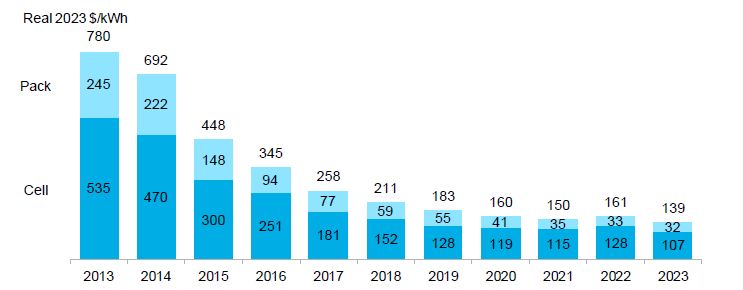Following unprecedented price increases in 2022, lithium-ion battery prices have dropped 14% so far this year to a record low of US$139 per kilowatt-hour (kWh) driven by raw material and component prices falling as production capacity increased across all parts of the battery value chain, while demand growth fell short of some industry expectations, according to a recent report.
However, battery demand across electric vehicles (EVs) and stationary energy storage is still on track to grow at a remarkable pace of 53% year-on-year, reaching 950 gigawatt-hours in 2023, finds the report by BloombergNEF (BNEF).
Despite this growth, major battery manufacturers reported lower utilization rates for their plants, while demand and revenue fell short of many companies’ expectations. As a result, many EV and battery makers, the BNEF report notes, revisited their production targets, which in turn impacted battery prices. Lithium prices reached a high point at the end of 2022, but fears that prices would remain high have largely subsided since then and prices are now falling again.
“This is another year where battery prices closely followed raw material prices,” says Evelina Stoikou, energy storage senior associate at BNEF. “In the many years that we’ve been doing this survey, falling prices have been driven by scale learnings and technological innovation, but that dynamic has changed. The drop in prices this year was attributed to significant growth in production capacity across the value chain in combination with weaker-than-expected demand.”
The price figures represent an average across multiple battery end-uses, including different types of EVs, buses and stationary storage projects. For battery electric vehicle (BEV) packs, prices, the report states, were US$128/kWh on a volume-weighted average basis in 2023. At the cell level, average prices for BEVs were just $89/kWh.
This indicates that, on average, cells account for 78% of the total pack price. Over the last four years, the cell-to-pack cost ratio, the report finds, has risen from the traditional 70:30 split. This is partially due to changes to pack design, such as the introduction of cell-to-pack approaches, which have helped reduce costs.
On a regional basis, average battery pack prices were lowest in China, at US$126/kWh. Packs in the US and Europe were 11% and 20% higher, respectively. Higher prices reflect the relative immaturity of these markets, higher production costs, lower volumes, and the diverse range of applications. There was also intense price competition domestically in China this year as battery manufacturers ramped up production capacity aiming to grab a share of the growing battery demand.
The industry continues to switch to the low-cost cathode chemistry known as lithium iron phosphate. These packs and cells had the lowest global weighted-average prices, the report’s data show, at US$130/kWh and US$95/kWh, respectively. This is the first year that the report’s analysis found LFP average cell prices falling below US$100/kWh. On average, LFP cells were 32% cheaper than lithium nickel manganese cobalt oxide cells in 2023.
Volume-weighted average lithium-ion battery pack and cell price split, 2013-2023

Source: BloombergNEF. Historical prices have been updated to reflect real 2023 dollars. Weighted average survey value includes 303 data points from passenger cars, buses, commercial vehicles and stationary storage.
Miners and metals traders surveyed expect prices for key battery metals like lithium, nickel and cobalt to ease further in 2024. Given this, the report expects average battery pack prices to drop again next year, reaching US$133/kWh (in real 2023 dollars). Technological innovation and manufacturing improvement should drive further declines in battery pack prices in the coming years, to US$113/kWh in 2025 and US$80/kWh in 2030.
“Battery prices have been on a rollercoaster over the past two years,” says Yayoi Sekine, head of energy storage at BNEF. “Large markets like the US and Europe are building up their local cell manufacturing, and we’re keenly watching how production incentives and tightening regulations on critical minerals will impact battery prices. These localization efforts will add a layer of complexity to how battery prices shape up regionally in coming years.”
Localization of battery manufacturing in regions like the US and Europe could exert upward pressure on battery pack prices as the local industries scale up. Battery manufacturing in the US and Europe have higher costs due to higher energy, equipment, land and labour costs compared with Asia, where most batteries are currently produced. Local policies, such as the US$45/kWh production tax credit for cells and packs under the Inflation Reduction Act in the US, could offset part of the cost, although the act’s impact on pricing is not yet clear.
Continued investment in R&D, manufacturing process improvements, and capacity expansion across the supply chain will help improve battery technology and reduce costs over the next decade. Next-generation technologies – such as silicon and lithium metal anodes, solid-state electrolytes, new cathode material and new cell manufacturing processes – will play, the report predicts, an important role in enabling further price reductions.









